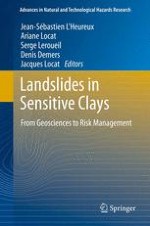Landslides in sensitive clays represent a major hazard in the northern countries of the world such as Canada, Finland, Norway, Russia, Sweden and in the US state of Alaska. Past and recent examples of catastrophic landslides at e.g. Saint-Jean-Vianney in 1971, Rissa in 1979, Finneidfjord in 1996 and Kattmarka in 2009 have illustrated the great mobility of the remolded sensitive clays and their hazardous retrogressive potential. These events call for a better understanding of landslide in sensitive clay terrain to assist authorities with state-of-the-art hazard assessment methods, risk management schemes, mitigation measures and planning. During the last decades the elevated awareness regarding slope movement in sensitive clays has led to major advances in mapping techniques and development of highly sophisticated geotechnical and geophysical investigation tools. Great advances in numerical techniques dealing with progressive failure and landslide kinematic have also lead to increase understanding and predictability of landslides in sensitive clays and their consequences. This volume consists of the latest scientific research by international experts dealing with geological, geotechnical and geophysical aspects of slope failure in sensitive clays and focuses on understanding the full spectrum of challenges presented by landslides in such brittle materials.
